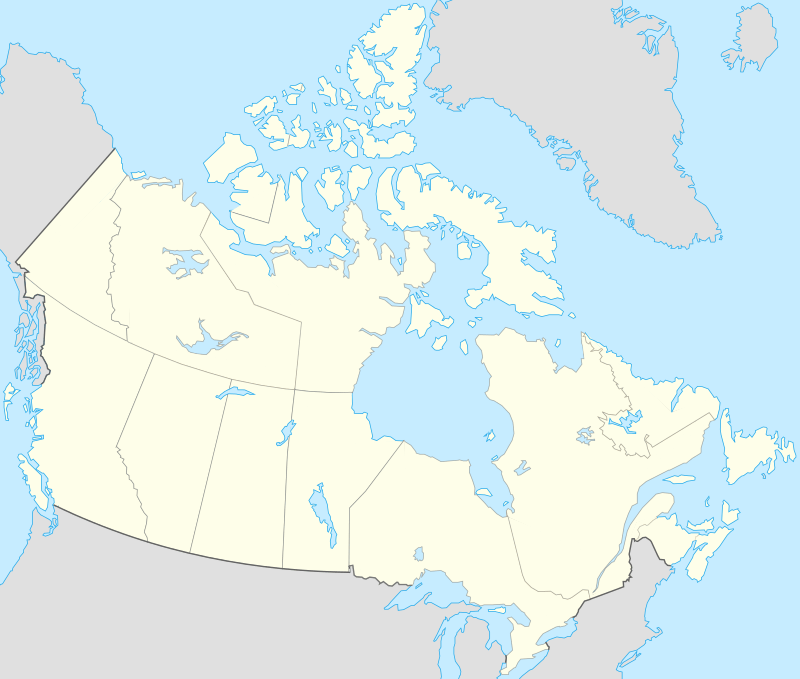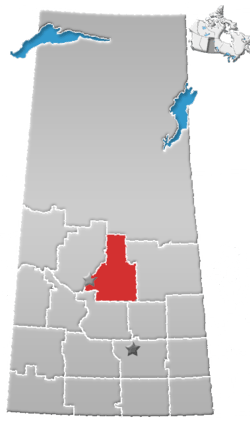Weldon, Saskatchewan
Weldon (2016 population: 197) is a village in the Canadian province of Saskatchewan within the Rural Municipality of Kinistino No. 459 and Census Division No. 15. The area is part of the aspen parkland biome. The village is located 2 km (1.2 mi) north of Highway 3 at the midway point between the cities of Prince Albert and Melfort, Saskatchewan. The village is just 20 km (12 mi) south of the Weldon Ferry linking it to Highway 302 and is often used as an access point to the historic Saskatchewan River Forks where the North and South Saskatchewan rivers join just 25 km (16 mi) to the northeast.
Village of Weldon | |
|---|---|
Village | |
Aerial view of Weldon Saskatchewan | |
 Weldon  Weldon | |
| Coordinates: 53°01′08″N 105°08′17″W | |
| Country | Canada |
| Province | Saskatchewan |
| Region | Saskatchewan |
| Census division | 15 |
| Rural Municipality | Kinistino |
| Post office Founded | 1895 |
| Government | |
| • Mayor | Howard Tarry |
| • Administrator | Shelley L. Holmes |
| • Governing body | Weldon Village Council |
| Area | |
| • Total | 1.10 km2 (0.42 sq mi) |
| Population (2006) | |
| • Total | 205 |
| • Density | 186.8/km2 (484/sq mi) |
| Time zone | UTC-6 (CST) |
| Postal code | S0J 3A0 |
| Area code(s) | 306 |
| Highways | Highway 682 |
| [1][2][3][4] | |
History
Weldon incorporated as a village on January 24, 1914.[5]
Weldon is historically recognized in that the first Canadian grain ever shipped through the port of Churchill, Manitoba and sent via freighter through the Hudson Bay was grown in the Weldon area. Of some note is the fact that hundred of thousands of bushels of grain from the area was sent via that port to Britain during World War II.
Demographics
In the 2016 Census of Population conducted by Statistics Canada, the Village of Weldon recorded a population of 197 living in 77 of its 93 total private dwellings, a 0.5% change from its 2011 population of 196. With a land area of 1.1 km2 (0.42 sq mi), it had a population density of 179.1/km2 (463.8/sq mi) in 2016.[8]
In the 2011 Census of Population, the Village of Weldon recorded a population of 196, a -4.4% change from its 2006 population of 205. With a land area of 1.1 km2 (0.42 sq mi), it had a population density of 178.2/km2 (461.5/sq mi) in 2011.[9]
Attractions
The village has seniors citizens lodge, a seniors club, a riding club, a winter recreation centre, an auditorium/gymnasium complex, a public library, a furnished summer sports field and worship centres for one denomination as well as a non-denominational assembly. The community is known for its old growth tree-lined streets and the natural environment of the farmland in the parkland region.
Weldon has modern amenities and services, and its population of approximately 200 enjoys a quiet, relaxed lifestyle reminiscent of another era. Many of the residents trace their lineage back to their Norwegian forebears who first established the community just after the turn of the previous century. Weldon's senior residents hold strong links to their roots in Norway and every May 17 a large "Syttende Mai" celebration is a significant cultural event in the village. The village's population grew fivefold during its 2005 Homecoming Celebrations held during the Canada Day weekend.
See also
- List of communities in Saskatchewan
- Villages of Saskatchewan
References
- National Archives, Archivia Net, Post Offices and Postmasters
- Government of Saskatchewan, MRD Home. "Municipal Directory System". Retrieved 2014-02-26.
- Canadian Textiles Institute. (2005), CTI Determine your provincial constituency
- Commissioner of Canada Elections, Chief Electoral Officer of Canada (2005), Elections Canada On-line
- "Urban Municipality Incorporations". Saskatchewan Ministry of Government Relations. Archived from the original on October 15, 2014. Retrieved June 1, 2020.
- "Saskatchewan Census Population" (PDF). Saskatchewan Bureau of Statistics. Archived from the original (PDF) on September 24, 2015. Retrieved May 31, 2020.
- "Saskatchewan Census Population". Saskatchewan Bureau of Statistics. Retrieved May 31, 2020.
- "Population and dwelling counts, for Canada, provinces and territories, and census subdivisions (municipalities), 2016 and 2011 censuses – 100% data (Saskatchewan)". Statistics Canada. February 8, 2017. Retrieved May 30, 2020.
- "Population and dwelling counts, for Canada, provinces and territories, and census subdivisions (municipalities), 2011 and 2006 censuses (Saskatchewan)". Statistics Canada. June 3, 2019. Retrieved May 30, 2020.
